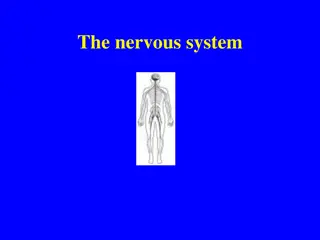Neurologic Disorder
Structural divisions of the central and peripheral nervous systems, learn about neuron anatomy, the neuromuscular junction, and the role of neurotransmitters. Includes information on Acetylcholine, Norepinephrine, Dopamine, and Serotonin.
0 views • 24 slides
Understanding Adrenergic Agents in Pharmaceutical Chemistry
Adrenergic agents play a crucial role in pharmacology by influencing the sympathetic nervous system through adrenergic receptors. These agents, such as sympathomimetics and sympatholytics, impact essential functions like cardiac activity, blood vessel dilation, and insulin release. Adrenergic neurot
0 views • 120 slides
Understanding the Nervous System: CNS, PNS, SNS, and ANS
The nervous system comprises the Central Nervous System (CNS) and Peripheral Nervous System (PNS), with the PNS further divided into the Somatic Nervous System (SNS) and Autonomic Nervous System (ANS). The SNS controls voluntary movements of skeletal muscles, while the ANS regulates involuntary proc
2 views • 23 slides
Brain Cells
Delve into the fascinating world of brain cells and neurons to understand their structure, function, and communication process. Explore the microscopic level composition of the brain, the significance of neuron shapes, and the intricate workings of synapses in transmitting signals between neurons. U
1 views • 14 slides
Understanding Electroconvulsive Therapy (ECT) for Psychiatric Treatment
Electroconvulsive Therapy (ECT), also known as electroshock, is a psychiatric treatment that induces seizures in anesthetized patients for therapeutic purposes. ECT has a controversial history but is well-established in the medical field. Introduced in 1938, ECT has replaced older treatments like in
1 views • 17 slides
Understanding Nerves and Muscles Physiology - Lecture Insights
Explore the intricate processes of synaptic transmission, neurotransmitters, spatial summation, temporal summation, chemical substances acting as neurotransmitters, and the effects of various factors and drugs on synapse function. Delve into the clinical significance of sedative-hypnotic drugs and t
0 views • 11 slides
Understanding Depression and Its Treatment: Old vs. New Drugs
Depression, a common mood disorder affecting millions, is characterized by neurochemical imbalances. Various forms of depression exist, ranging from mild to severe and even psychotic. Symptoms include loss of interest, feelings of worthlessness, and recurrent thoughts of death. Treatment involves in
0 views • 28 slides
Cell Communication and Signalling in Biology
Cells communicate through extracellular signalling molecules that bind to specific receptors on target cells, leading to changes in cellular behavior. Hormones such as steroid and peptide hormones, neurotransmitters like nor-adrenaline and acetylcholine, play crucial roles in cell signaling. Recepto
0 views • 25 slides
Understanding Motor Units and Neurotransmitters in Muscle Contraction
Motor units consist of a motor neuron and the muscle fibers it innervates. Neurotransmitters like acetylcholine play a vital role in stimulating muscle contraction by transmitting signals at the neuromuscular junction. This communication between neurons and muscles is essential for proper movement a
0 views • 30 slides
Understanding Adrenergic Transmission and Catecholamine Synthesis
Adrenergic transmission involves the release of neurotransmitters such as norepinephrine, dopamine, and epinephrine at synapses or neuroeffector junctions. These neurotransmitters, known as catecholamines, play crucial roles in transmitting impulses in the sympathetic nervous system and central nerv
0 views • 14 slides
Buy Valium 10mg Online - globaldrugsstore.com
Buy Valium 10mg Online contains the active ingredient diazepam, which belongs to the benzodiazepine class of drugs. It works by enhancing the activity of certain neurotransmitters in the brain, leading to a calming effect.\nText\/ WhatsApp: 1 (234)
1 views • 3 slides
Understanding the Nervous System: Functions, Sense Organs, and Reflex Actions
The nervous system, consisting of the brain, spinal cord, and nerves, is crucial for sensing and responding to stimuli in our environment. Sense organs like the eyes, ears, and skin help detect changes, while reflex actions provide immediate responses. Synapses and neurotransmitters play a role in t
0 views • 14 slides
Understanding CNS Stimulants and Their Effects on the Nervous System
Exploring the world of central nervous system stimulants, this content delves into the mechanisms of action of stimulant drugs, highlights the neurotransmitters involved, and discusses the signs and symptoms of CNS stimulation. It covers the use of amphetamine in conditions like narcolepsy, attentio
0 views • 65 slides
Understanding the Brain: Key Components and Functions Explored
Explore the intricate workings of the brain, from the essential role of the brainstem in vital functions to the coordination by the cerebellum and the emotional control of the limbic system. Discover how the executive branch regulates decision-making and the interplay between nature and nurture on h
0 views • 31 slides
Understanding the Role of Basal Ganglia in the Autonomic Nervous System
Basal ganglia, located in the cerebrum, play a crucial role in motor control and regulatory mechanisms. This lecture covers the physiology of basal ganglia, including different nuclei and neurotransmitters involved, their general functions, and diagnosing associated disorders. The component anatomy,
0 views • 36 slides
Overview of the Central Nervous System and Neurotransmitters
The human central nervous system (CNS) is composed of neurons that transmit information through electrical impulses and neurotransmitters at synaptic junctions. Synapses play a crucial role in interneuronal communication, with various types and features impacting information transmission. Neurotrans
0 views • 13 slides
Understanding Pharmacology: Introduction to Neurotransmitters and Nervous System
This content delves into the fundamentals of neuropharmacology, exploring concepts such as dose-response curves, afferent and efferent neurons, peripheral nervous system divisions, neurotransmitter functions, and neurochemical classifications. It covers the roles of cholinergic, adrenergic, and dopa
0 views • 29 slides
Overview of Antipsychotic Drugs and Treatment for Psychotic Disorders
Antipsychotic drugs play a vital role in managing psychotic disorders by targeting dopamine and serotonin receptors. This overview covers the mechanism of action, classification (typical vs. atypical), side effects, and therapeutic efficacy of antipsychotic medications. It also delves into the mood-
0 views • 31 slides
Understanding the Physiology of Basal Ganglia and Regulatory Mechanisms
This lecture covers the physiology of basal ganglia, including the different nuclei, pathways, and neurotransmitters involved. It explains the functions of caudate and putamen circuits, integration of direct and indirect pathways, and diagnosis of basal ganglia disorders. The connections and basic c
0 views • 24 slides
Investigating the Impact of Silencing the APP Gene and Stimulating the CaMKII Pathway on Synaptic Plasticity in Alzheimer's Disease
This study explores the effects of silencing the APP gene and activating the CaMKII pathway on synaptic plasticity in Alzheimer's disease. The experiment aims to maintain the secretion of neurotransmitters by presynaptic neurons when the APP gene is knocked out, potentially offering insights into no
0 views • 11 slides
Understanding Depression and Antidepressant Drug Classification
Depression is a severe mental disorder characterized by persistent low mood, affecting various aspects of a person's life. The causes of depression are diverse, including physical conditions, environmental factors, and genetic predisposition. Recognizing the symptoms is crucial for timely interventi
0 views • 31 slides
Understanding the Intricacies of the Nervous System
Delve into the intricate workings of the nervous system, encompassing the brain, spinal cord, and nerves. Explore key components such as neurons, neurotransmitters, and reflexes, essential for perceiving and responding to stimuli. Uncover the vital role of this control system in interpreting the ext
0 views • 17 slides
Understanding Biological Factors and Crime: Genetics, Neurotransmitters, Neuro-biology
Biological factors such as genetics, neurotransmitters, and neuro-biology play significant roles in influencing criminal behavior. Genetics can predispose individuals to antisocial behavior, neurotransmitters like serotonin and norepinephrine impact social behavior, and neuro-biological damage can l
0 views • 13 slides
Understanding Glutamate: The Primary Excitatory Neurotransmitter
Glutamate and aspartate are primary excitatory neurotransmitters in the CNS, playing crucial roles in neural function. Glutamate is involved in various pathways, including synthesis, metabolism, and receptor interactions, impacting learning, memory, and excitotoxicity. Glutamate receptors, such as N
0 views • 16 slides
Understanding Schizophrenia: Insights from Carlsson et al.'s 2000 Study
Carlsson et al.'s 2000 study on schizophrenia explores the dopamine hypothesis, highlighting the interplay of neurotransmitters like glutamate, serotonin, and GABA. They suggest future drug treatments for schizophrenia, emphasizing the need to consider neurotransmitter interactions beyond dopamine.
0 views • 17 slides
Overview of Endocrinology: Coordination of Body Functions by Chemical Messengers
The body's functions are coordinated by various chemical messenger systems, including neurotransmitters, endocrine hormones, neuroendocrine hormones, paracrines, autocrines, and cytokines. Endocrine hormones travel through the circulatory system, binding to receptors in cells to regulate metabolism,
0 views • 18 slides
Understanding Developmental Psychopathology: Models, Theories, and Perspectives
This content delves into the field of developmental psychopathology, exploring the use of models and theories in understanding maladaptive behaviors. It emphasizes the importance of considering developmental processes and normative behaviors, evaluating theories based on comprehensiveness, parsimony
1 views • 45 slides


























